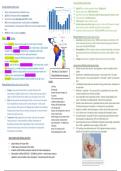Amazon Rainforest Carbon Cycle:
Amazon Rainforest Water Cycle:
High NPP due to humid equatorial climate: 2500g/m2/yr
Water cycles between basin and Atlantic ocean Biomass carbon store: 400-700 tonnes/ha
20-25% of intercepted rainfall is evapourated Large forest trees store: 180 tonnes carbon/ha above ground, 40 tonnes in roots
Soil carbon stores: 90-200 tonnes/ha
Dense forest canopy intercepts up to 75% of rainfall
2.4bil tonnes of carbon stored/yr overall
50% of non-evapourated water is used by plants and returned by
Limited carbon and nutrient stores in leached & acidic soil BUT speed of recycling
evapotranspiration, remaining water infiltrates into soil & stored/groundwater
allows biome with such a high NPP and biomass to be supported
flow Amazonian rainforest accounts for 15-25% of all NPP in terrestrial ecosystems
50-60% of water recycled by evapotran.
Physical Factors Affecting Carbon Stores & Flows:
Stores & Flows of Water:
1. Forest trees: principal carbon stores, 100bil tonnes locked up in rainforest, 1.7bil
o Dense Vegetation: absorbs & stores water from soil, releases it through tonnes released by decomp./yr, 60% of carbon stored above ground in biomass =
carbon sink of GLOBAL IMPORTANCE
evapouration, high rates of evapotranspiration due to high temps. & high absolute
2. Decomposition: leaf litter & organic matter accumulates temporarily at soil surface
humidity = high precipitation feedback loops. Transpiration water brings
but quickly broken down by decomposers due to warm, humid conditions = emits
dust/minerals into atmosphere with it = aids cloud formation CO2
o Soil/Groundwater: abundant rainfall & deep tropical soils = significant water 3. Geology: limestone acts a significant regional carbon store near the Andes
storage in soils & aquifers
o Run-Off: rapid run-off due to intensive rainfall events & well-drained soils = peak in Human Factors Affecting Carbon Stores & Flows:
river discharge for 1-2 months/yr based on seasonal distribution of rainfall Pollution of water from oil spills = dead organisms = water is unusable for local
o Precipitation: >2000mm average rainfall, no dry season but some months with Key Idea 2a: Case Study of people.
slightly less rain, mostly high-intensity convectional rainfall Tropical Rainforest Amazonia Extraction for residential/industrial purposes = lower water levels = less water
o Atmosphere: high absolute humidity & relative humidity due to high temps. taken up by plants = less evapotranspiration = less clouds + rainfall = area becomes
Fact File: drier
Physical Factors Affecting Stores & Flows of Water: 1 football pitch deforested every minute for farming, infrastructure, hydropower &
6 mil km2 oil exploration
1. Geology: large parts of Amazon basin = ancient shield area with 30mil people Rainforest -> grassland = 27x more run-off & ½ precipitation lost to rivers which
impermeable, crystalline, igneous rocks = minimal water storage capacity = Amazon mainstem, Rio Negro, etc. contains important trace nutrients (Ca/Mg/K)
9 countries Less cooling effect from transpiration & VOCs = climatic change (global & local
rapid run-off BUT limestone near Andes stores rainwater & slow run-off
70% of rainforest in Brazil
2. Relief: mostly extensive lowlands (gentle relief) = water moves by overland scale) = 20% decline in rainfall predicted = effects forests downwind
25,000 km2 deforestation/yr
flow/ throughflow to streams and rivers. West Amazonia = Andes create Exhausts carbon biomass store as grasslands store less carbon & have lower inputs:
Produces 20% of global oxygen
steep catchments with rapid run-off. Widespread inundation across extensive 16.3tonnes/ha biomass in rainforest vs 2.7tonnes/ha in soya cultivation
27°C average temp.
floodplains (eg: Pantanal) occurs annually, storing water for several months =
Exposure to sunlight = fewer decomposers = slower rate of carbon return to soil
Dynamic, fast moving biome in terms of
Loss of forest cover = bio-spheric carbon is replaced with atmospheric carbon
slowing movement into rivers cycles of water/carbon
World’s largest tract of rainforest with
Increased drought = increased fire risk for scrublands/grasslands (former forest) =
3. Temperature: High temperatures year-round = high rates of evapotran.
mostly evergreen, hardwood trees CO2 released by combustion (Eg: 1997 and 1998 El Nino fires)
Strong convection = high atmospheric humidity, development of Woods Hole Research Centre: 400,000km2 of Brazilian Amazon highly vulnerable to
Avg. deforestation = 17,500km2/year
thunderstorm clouds & intense precipitation. Water cycled continually fire in 1998 = amplified by worse droughts in 2005 & 2010
1970-2013
between the land surface, forest trees & atmosphere by evapouration, Almost 1/5 of primary forest CO2 emissions from deforestation add ~10% to global warming by reducing
transpiration & precipitation. destroyed/degraded since 2017 quantity of CO2 pulled by world's forests from atmosphere
Upper Madeira Basin flooding, April 2014
o largest tributary of Amazon River
o 19.68m above normal levels at Porto Velho
o 60 deaths, 68,000 families evacuated, outbreaks of cholera & leptospirosis
o deforestation in Bolivia (2000-2012 = 30,000km2) and Peru = reduced water storage in
vegetation, soils, permeable rocks & atmosphere = increased speed of total runoff





